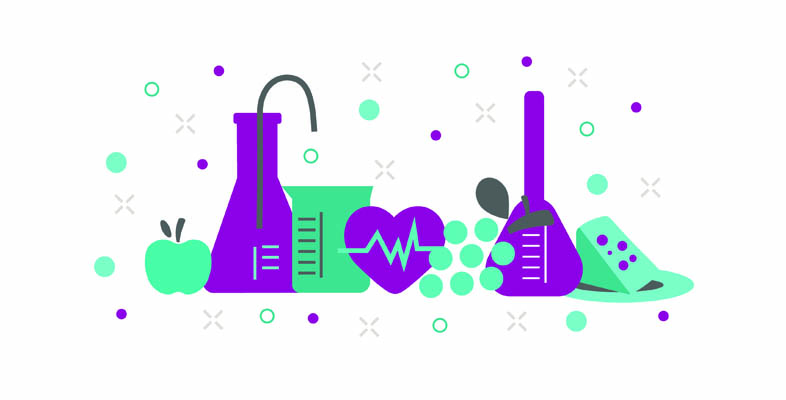2 Protein
While the nutrition label lists ‘protein’ as though it is one substance, there are thousands of different proteins in our food, and thousands in our body. We need to eat protein in our food mainly so that we can make our own proteins.
Our digestive system breaks down the proteins in the food we eat into their component molecules, called amino acids. Then the amino acids join up again, using different numbers of them (from fewer than ten to several thousand) in a different – but very definite – order, to make our own proteins. Each amino acid molecule has a chemical ‘hook’ on each end, so that it can attach to any other one, to make the proteins we need, like a series of carriages on a very long train. The code that determines the sequence of amino acids (the order of the ‘carriages’) is in our DNA.
There are about 20 different amino acids. Eight of them are essential in the diet. We can make the others from those eight if necessary (see Table 1). Most people take in a sufficient amount and good mix of protein that they don’t need to worry about getting enough of the essential amino acids. People on a strict vegan diet may need to take more care to eat a mix of different plant proteins (particularly beans) to ensure that they have enough.
For adults, the reference nutrient intake (RNI) is 0.75 g of protein per kilogram of body weight per day. For an average man weighing 83kg, his protein needs are 62g per day. For an average woman weighing 70kg, her protein needs are 53g. However, an average western diet contains much more protein than that.
| Essential amino acids | Amino acids synthesised from essential amino acids | Non-essential amino acids |
|---|---|---|
| lysine (Lys) | tyrosine (Tyr) * | glycine (Gly) |
| methionine (Met) | cysteine (Cys) + | alanine (Ala) |
| threonine (Thr) | histidine (His) – made only in very small amounts in the body | serine (Ser) |
| leucine (Leu) | arginine (Arg) – essential for young children | proline (Pro) |
| isoleucine (IIe) | glutamate (Glu) | |
| valine (Val) | glutamine (Gln) | |
| phenylalanine (Phe) | asparate (Asp) | |
| tryptophan (Try) | asparagine (Asn) |
Proteins are an essential component of our muscles and other structures in our body, such as hair, nails and tendons. As well as these structural proteins, there are proteins in our blood that function as hormones. Others form part of our immune system, which protects us against infection. The proteins in the food we eat are digested by enzymes which are also proteins.
The excess amino acids in our diet cannot be stored for long in the body, if they are not needed for building new proteins. They are taken in the bloodstream to the liver, where they are broken down. The part of the amino acid containing the nitrogen is converted into urea. This circulates in the blood to the kidneys, which provide an amazing biological filtering system. They filter out the urea and send it down tubes to the bladder, along with other substances the body does not need, and excess water, forming urine. So, when you urinate, you are getting rid of surplus amino acids.
